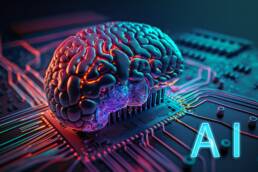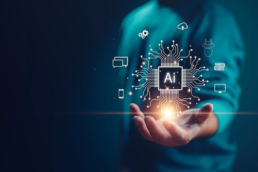Artificial intelligence is transforming businesses in nearly every industry. While consumer tech giants tend to get the lion’s share of media attention for their flashy AI projects, arguably the most profound impacts are happening in the enterprise. Behind the scenes, companies across sectors from finance to manufacturing to healthcare are leveraging AI to drive insights, automate processes, and stay ahead of the competition.
In this post, we’ll explore some of the most exciting ways that AI is reshaping enterprise software and creating tangible value for organizations.
Automating Mundane Tasks with RPA
One of the clearest applications of AI is using software bots to automate repetitive, rules-based tasks. This approach, known as robotic process automation (RPA), is rapidly gaining traction as a way to reduce costs and free up employees to focus on higher-value work.
For instance, major banks are deploying thousands of bots to handle processes like loan application data entry, claims processing, and regulatory compliance audits. According to McKinsey, the average RPA project sees costs reduced by 25-50% while cutting process time by 40-75%. And RPA doesn’t require deep technical skills to implement, making it feasible for organizations of all sizes.
But it’s not just about cost-cutting. As Accenture notes, RPA also boosts productivity, accuracy, compliance, and employee satisfaction by liberating workers from the drudgery of repetitive tasks. It’s a win-win for both companies and employees.
Augmenting Human Decision Making
While RPA handles structured digital tasks, complementary technologies like machine learning can assist humans with more complex work. These tools leverage AI techniques like computer vision, natural language processing, and predictive analytics to spot patterns in data and suggest decisions or next best actions.
In the healthcare sector, such augmented intelligence helps clinicians analyze patient records, lab results, and medical imaging to provide personalized treatment recommendations for conditions from cancer to heart disease. In hospitals where the technology has been deployed, length of stay and readmission rates have dropped, outcomes have improved, and medical costs have declined significantly.
Likewise, manufacturers are utilizing AI-powered computer vision on production lines to automatically spot defects and surface quality issues in real time. This allows companies to reduce quality control costs, minimize wastage, and boost yields. According to PwC, manufacturers expect efficiency gains of 9-12% and cost reductions of 3-5% from smart factory AI implementations.
Reimagining Core Business Processes
Beyond discrete automation and decision support applications, AI is enabling the revolutionary reinvention of entire business processes and operating models. Companies that fully embrace this transformation potential stand to gain dramatic competitive advantages.
For example, leading insurance providers are using IoT sensor data, satellite imagery, and AI risk models to offer usage-based, on-demand coverage for assets from connected vehicles to corporate equipment fleets. This gives customers the flexibility to customize policies based on real usage patterns. Meanwhile, insurers improve underwriting accuracy and can incentivize customers to reduce claims through behavior modifications – a potential win-win.
In the financial sector, AI techniques like natural language processing, sentiment analysis, and predictive analytics are being combined to generate actionable market intelligence and trading signals from alternative data sources like news, social media, and web traffic. Though strategies differ, studies show AI-driven hedge funds and quant trading firms now account for nearly a third of all US stock trades by volume.
Across domains, AI allows for data-driven iteration of business models faster than ever before. Companies need to build institutional capacity to intelligently experiment with and scale up successful models while managing the inevitable change management challenges.
The Human Impact
Given the scale of the potential transformation, what does AI mean for human employees? Pessimistic perspectives highlight job displacement, though the consensus view seems more balanced.
According to McKinsey, while 60% of occupations have at least 30% of activities that are automatable with current technology, fewer than 5% of jobs can be fully automated. They predict that AI will displace very few occupations entirely in the next decade while augmenting many more – possibly boosting global productivity by up to 1.4%.
Longer-term, the nature of work will likely shift toward higher cognitive-skill activities like creativity, collaboration, interpretation, and problem-solving. Employees who can adapt to the usage of AI tools will likely see their capabilities enhanced. But lower-skilled workers unable to augment their capabilities could face displacement, prompting calls for expanded education, training programs, and social safety nets to cushion the transition.
Overall, organizations must take care to deploy AI ethically, transparently, and with respect for employees’ interests – minimizing excessive surveillance or micromanagement. Studies show that keeping humans “in the loop” and focusing AI on enhancing capabilities produces better outcomes all around.
The Future Is Here
Across functions and verticals, AI is already transforming enterprise operations and unlocking new sources of value. From automation to insight augmentation to business model reinvention, companies have only scratched the surface of possibilities. Leaders will need to deeply integrate AI capabilities across their organizations to realize their full potential.
But it’s no longer speculative – the future is here, and AI adoption is accelerating. Companies that fail to make strategic investments risk rapid competitive obsolescence. Of course, forethought and diligence are required to navigate risks like employee displacement, biased data, and ethical implications – challenges that wise organizations will address proactively and positively.
Those able to leverage AI with prudence and vision can look forward to gains from greater efficiency, quality, insight, innovation, and customer-centricity over their peers. The rewards will be substantial, but only for those bold enough to embrace AI as a core part of their digital transformation strategies. The time for hesitant small steps is over – now is the time to take the plunge into our AI-driven business future.




